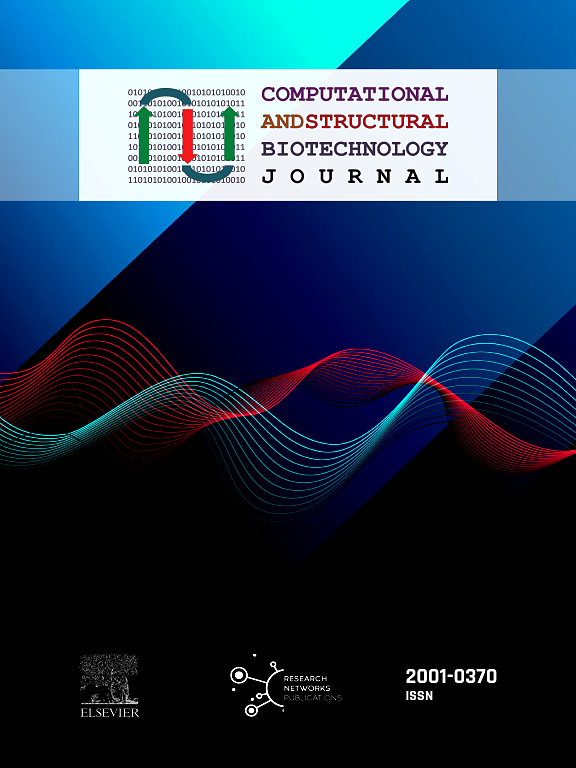UQCRB 和 LBH 与前列腺癌的格里森评分进展相关:空间转录组学和实验验证
IF 4.4
2区 生物学
Q2 BIOCHEMISTRY & MOLECULAR BIOLOGY
Computational and structural biotechnology journal
Pub Date : 2024-08-30
DOI:10.1016/j.csbj.2024.08.026
引用次数: 0
摘要
前列腺癌(PCa)是一种多灶性疾病,其特点是单个腺体内基因组和表型的异质性。在这项研究中,Visium空间转录组学(ST)分析法被应用于不同组织学结构的PCa组织,以推断参与格里森评分(GS)进展的分子事件。利用主成分分析(PCA)和基于转录组数据的鲁汶聚类分析将组织切片中的斑点分为不同的组。根据GS对斑点进行的注释显示,转录组特征与组织学上可识别的结构之间存在明显的相似性。通过恶性肿瘤相关特征分析,特别是推断拷贝数变异(inferred copy number variation,inferCNV),以及发展轨迹分析,如扩散伪时间(diffusion pseudotime,DPT)和基于分区的图抽象(partition-based graph abstraction,PAGA),从生物信息学角度验证了宏观GS测定的准确性。通过沿 GS 梯度对各组进行配对比较,从差异表达基因(DEGs)中确定了与 GS 进展相关的基因。研究发现,具有代表性的癌基因 UQCRB 和 LBH 所编码的蛋白质在晚期 PCa 组织中高度表达。敲除它们的mRNA能显著抑制PCa细胞的增殖和侵袭。这些发现通过癌症基因组图谱前列腺癌(TCGA-PRAD)数据集以及组织学和细胞学实验得到了验证。本文介绍的结果为基于ST的GS进展评估奠定了基础,并为GS进展相关基因UQCRB和LBH提供了有价值的见解。本文章由计算机程序翻译,如有差异,请以英文原文为准。
UQCRB and LBH are correlated with Gleason score progression in prostate cancer: Spatial transcriptomics and experimental validation
Prostate cancer (PCa) is a multifocal disease characterized by genomic and phenotypic heterogeneity within a single gland. In this study, Visium spatial transcriptomics (ST) analysis was applied to PCa tissues with different histological structures to infer the molecular events involved in Gleason score (GS) progression. The spots in tissue sections were classified into various groups using Principal Component Analysis (PCA) and Louvain clustering analysis based on transcriptome data. Anotation of the spots according to GS revealed notable similarities between transcriptomic profiles and histologically identifiable structures. The accuracy of macroscopic GS determination was bioinformatically verified through malignancy-related feature analysis, specifically inferred copy number variation (inferCNV), as well as developmental trajectory analyses, such as diffusion pseudotime (DPT) and partition-based graph abstraction (PAGA). Genes related to GS progression were identified from the differentially expressed genes (DEGs) through pairwise comparisons of groups along a GS gradient. The proteins encoded by the representative oncogenes UQCRB and LBH were found to be highly expressed in advanced-stage PCa tissues. Knockdown of their mRNAs significantly suppressed PCa cell proliferation and invasion. These findings were validated using The Cancer Genome Atlas Prostate Adenocarcinoma (TCGA-PRAD) dataset, as well as through histological and cytological experiments. The results presented here establish a foundation for ST-based evaluation of GS progression and provide valuable insights into the GS progression-related genes UQCRB and LBH.
求助全文
通过发布文献求助,成功后即可免费获取论文全文。
去求助
来源期刊

Computational and structural biotechnology journal
Biochemistry, Genetics and Molecular Biology-Biophysics
CiteScore
9.30
自引率
3.30%
发文量
540
审稿时长
6 weeks
期刊介绍:
Computational and Structural Biotechnology Journal (CSBJ) is an online gold open access journal publishing research articles and reviews after full peer review. All articles are published, without barriers to access, immediately upon acceptance. The journal places a strong emphasis on functional and mechanistic understanding of how molecular components in a biological process work together through the application of computational methods. Structural data may provide such insights, but they are not a pre-requisite for publication in the journal. Specific areas of interest include, but are not limited to:
Structure and function of proteins, nucleic acids and other macromolecules
Structure and function of multi-component complexes
Protein folding, processing and degradation
Enzymology
Computational and structural studies of plant systems
Microbial Informatics
Genomics
Proteomics
Metabolomics
Algorithms and Hypothesis in Bioinformatics
Mathematical and Theoretical Biology
Computational Chemistry and Drug Discovery
Microscopy and Molecular Imaging
Nanotechnology
Systems and Synthetic Biology
 求助内容:
求助内容: 应助结果提醒方式:
应助结果提醒方式:


